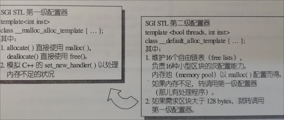STL之空间配置器allocator
摘要
C++STL的空间配置器将内存的分配、释放,对象的构造、析构都分开执行,内存分配由alloc::allocate()负责,内存的释放由alloc::deallocate()负责;对象的构造由::construct()负责,对象的析构由::destroy()负责。
构造和析构:construct()和destroy()
下面为源码和注释:
#include <new.h> //使用placement new//使用placement new在已经分配的内存上构造对象template <class T1, class T2>inline void construct(T1* p, const T2& value) {new (p) T1(value);}//第一个版本,接受一个指针//调用对象的析构函数,它需要有non-trivial destructortemplate <class T>inline void destroy(T* pointer) {pointer->~T();}//第二个版本//针对迭代器为char*和wchar_t*的特化版本inline void destroy(char*, char*) {}inline void destroy(wchar_t*, wchar_t*) {}//接受两个迭代器,找出元素的类型template <class ForwardIterator>inline void destroy(ForwardIterator first, ForwardIterator last) {__destroy(first, last, value_type(first));}//判断元素的类型是否有trivial destructortemplate <class ForwardIterator, class T>inline void __destroy(ForwardIterator first, ForwardIterator last, T*) {typedef typename __type_traits<T>::has_trivial_destructor trivial_destructor;__destroy_aux(first, last, trivial_destructor());}//元素的类型有non-trivial destructortemplate <class ForwardIterator>inline void__destroy_aux(ForwardIterator first, ForwardIterator last, __false_type) {for ( ; first < last; ++first)destroy(&*first);}//元素的类型有trivial destructortemplate <class ForwardIterator>inline void __destroy_aux(ForwardIterator, ForwardIterator, __true_type) {}
空间的配置和释放: std::alloc
在内存配置方面,STL分为两级配置器,当请求的内存大于128bytes的时候调用第一级配置器,当请求的内存小于等于128bytes的时候调用第二级配置器。如图:

第一级配置器源码:
template <int inst>class __malloc_alloc_template{private://调用malloc函数不成功后调用static void *oom_malloc(size_t);//调用realloc函数不成功后调用static void *oom_realloc(void *, size_t);//类似于C++的set_new_handle错误处理函数一样,如果不设置,在内存不足时,返回THROW_BAD_ALLOC#ifndef __STL_STATIC_TEMPLATE_MEMBER_BUGstatic void (* __malloc_alloc_oom_handler)();#endifpublic://直接调用malloc来分配内存static void * allocate(size_t n){void *result = malloc(n);if (0 == result) result = oom_malloc(n); //如果分配失败,则调用oom_malloc()return result;}//第一级配置器直接调用free来释放内存static void deallocate(void *p, size_t /* n */){free(p);}//直接调用reallloc来分配内存static void * reallocate(void *p, size_t /* old_sz */, size_t new_sz){void * result = realloc(p, new_sz);if (0 == result) result = oom_realloc(p, new_sz); //如果realloc分配不成功,调用oom_realloc()return result;}//异常处理函数,即内存分配失败后的处理static void (* set_malloc_handler(void (*f)()))(){void (* old)() = __malloc_alloc_oom_handler;__malloc_alloc_oom_handler = f;return(old);}};// 以下是针对内存分配失败后的处理//首先,将__malloc_alloc_oom_handler的默认值设为0template <int inst>void (* __malloc_alloc_template<inst>::__malloc_alloc_oom_handler)() = 0;#endiftemplate <int inst>void * __malloc_alloc_template<inst>::oom_malloc(size_t n){void (* my_malloc_handler)();void *result;for (;;) { // 不断地尝试释放、再配置、再释放、再配置my_malloc_handler = __malloc_alloc_oom_handler;if (0 == my_malloc_handler) { __THROW_BAD_ALLOC; } //这里是当没有设置处理函数的时候,直接抛出异常(*my_malloc_handler)(); // 调用处理例程,尝试释放内存result = malloc(n); // 再重新分配内存if (result) return(result); // 如果分配成功则返回指针}}template <int inst>void * __malloc_alloc_template<inst>::oom_realloc(void *p, size_t n){void (* my_malloc_handler)();void *result;for (;;) { //不断地尝试释放、再配置、再释放、再配置my_malloc_handler = __malloc_alloc_oom_handler;if (0 == my_malloc_handler) { __THROW_BAD_ALLOC; } //这里是当没有设置处理函数的时候,直接抛出异常(*my_malloc_handler)(); // 调用处理例程,尝试释放内存result = realloc(p, n); // 再重新分配内存if (result) return(result); // 如果分配成功则返回指针}}
第二级配置器源码:
enum {__ALIGN = 8}; //小型区块的上调边界enum {__MAX_BYTES = 128}; //小型区块的上限enum {__NFREELISTS = __MAX_BYTES/__ALIGN}; //free-lists个数//第一参数用于多线程,这里不做讨论。template <bool threads, int inst>class __default_alloc_template{private:// 此函数将bytes的边界上调至8的倍数static size_t ROUND_UP(size_t bytes){return (((bytes) + __ALIGN-1) & ~(__ALIGN - 1));}private:union obj{union obj * free_list_link;char client_data[1];};private://16个free-listsstatic obj * __VOLATILE free_list[__NFREELISTS];// 根据待待分配的空间大小, 在free_list中选择合适的大小static size_t FREELIST_INDEX(size_t bytes){return (((bytes) + __ALIGN-1)/__ALIGN - 1);}// 返回一个大小为n的对象,并可能加入大小为n的其它区块到free-listsstatic void *refill(size_t n);// 配置一大块空间,可容纳nobjs个大小为“size”的区块// 如果配置nobjs个区块有所不便,nobjs可能会降低,所以需要用引用传递static char *chunk_alloc(size_t size, int &nobjs);// 内存池static char *start_free; // 内存池起始点,只在chunk_alloc()中变化static char *end_free; // 内存池结束点,只在chunk_alloc()中变化static size_t heap_size; // 已经在堆上分配的空间大小public:static void* allocate(size_t n);// 空间配置函数static void deallocate(void *p, size_t n); // 空间释放函数static void* reallocate(void* p, size_t old_sz , size_t new_sz); //空间重新配置函数}// 一些静态成员变量的初始化// 内存池起始位置template <bool threads, int inst>char *__default_alloc_template<threads, inst>::start_free = 0;// 内存池结束位置template <bool threads, int inst>char *__default_alloc_template<threads, inst>::end_free = 0;// 已经在堆上分配的空间大小template <bool threads, int inst>size_t __default_alloc_template<threads, inst>::heap_size = 0;// 内存池容量索引数组template <bool threads, int inst>__default_alloc_template<threads, inst>::obj * __VOLATILE__default_alloc_template<threads, inst> ::free_list[__NFREELISTS ] ={0, 0, 0, 0, 0, 0, 0, 0, 0, 0, 0, 0, 0, 0, 0, 0, };// The 16 zeros are necessary to make version 4.1 of the SunPro// compiler happy. Otherwise it appears to allocate too little// space for the array.public://空间配置函数allocate()static void * allocate(size_t n){//指向freelist的指针obj * __VOLATILE * my_free_list;obj * __RESTRICT result;//区块size大于128就调用一级配置器,n已被上调至8的倍数if (n > (size_t) __MAX_BYTES) {return(malloc_alloc::allocate(n));}//寻找freelists中适当的一个my_free_list = free_list + FREELIST_INDEX(n);result = *my_free_list;//没有找到可用的freelist,就重新填充freelistif (result == 0) {void *r = refill(ROUND_UP(n));return r;}//调整freelist*my_free_list = result -> free_list_link;return (result);};//空间释放函数deallocate()//p不能为nullptrstatic void deallocate(void *p, size_t n){obj *q = (obj *)p;obj * __VOLATILE * my_free_list;//如果大于128就调用第一级的释放函数if (n > (size_t) __MAX_BYTES) {malloc_alloc::deallocate(p, n);return;}//找到对应的freelistmy_free_list = free_list + FREELIST_INDEX(n);//调整freelist,回收区块q -> free_list_link = *my_free_list;*my_free_list = q;}} ;//内存池函数chunk_allco()template <bool threads, int inst>char*__default_alloc_template<threads, inst>::chunk_alloc(size_t size, int& nobjs){char * result;//所需容量size_t total_bytes = size * nobjs;//内存池剩余容量size_t bytes_left = end_free - start_free;//如果余量足够if (bytes_left >= total_bytes) {result = start_free;start_free += total_bytes;return(result);}//余量不能完全满足需求,但至少能供应1个区块else if (bytes_left >= size) {//计算能供应的最多节点个数nobjs = bytes_left/size;total_bytes = size * nobjs;result = start_free;//调整内存池开始位置start_free += total_bytes;return(result);} else {//余量严重不足size_t bytes_to_get = 2 * total_bytes + ROUND_UP(heap_size >> 4);// 将剩余内存分配给指定的free_list[FREELIST_INDEX(bytes_left)]if (bytes_left > 0) {//内存池还有一些零头//寻找适当的freelistobj * __VOLATILE * my_free_list =free_list + FREELIST_INDEX(bytes_left);//调整freelist,将内存池中剩余内存编入((obj *)start_free) -> free_list_link = *my_free_list;*my_free_list = (obj *)start_free;}//用malloc配置空间,补充内存池start_free = (char *)malloc(bytes_to_get);//malloc失败if (0 == start_free) {int i;obj * __VOLATILE * my_free_list, *p;// Try to make do with what we have. That can't// hurt. We do not try smaller requests, since that tends// to result in disaster on multi-process machines.//不打算配置更小区块,那在多进程机器上会有灾难,无法让其他进程获取内存//检查freelist中的可用空间,且区块足够大for (i = size; i <= __MAX_BYTES; i += __ALIGN) {my_free_list = free_list + FREELIST_INDEX(i);p = *my_free_list;if (0 != p) {//有可用空间,将其加入内存池*my_free_list = p -> free_list_link;start_free = (char *)p;end_free = start_free + i;//内存池更新完毕,重新分配内存return(chunk_alloc(size, nobjs));//任何剩余零头将被编入适当的freelist以备用// Any leftover piece will eventually make it to the// right free list.}}//分配失败,就调用一级分配器分配,期待异常处理函数提供帮助end_free = 0; // In case of exception.start_free = (char *)malloc_alloc::allocate(bytes_to_get);// This should either throw an// exception or remedy the situation. Thus we assume it// succeeded.}heap_size += bytes_to_get;end_free = start_free + bytes_to_get;//内存池更新完毕,重新分配内存return(chunk_alloc(size, nobjs));}}//重新填充freeliststemplate <bool threads, int inst>void* __default_alloc_template<threads, inst>::refill(size_t n){//20个区块int nobjs = 20;//调用chunk_alloc(),尝试取nobjs个区块作为freelist的新节点//nobjs为引用传递char * chunk = chunk_alloc(n, nobjs);obj * __VOLATILE * my_free_list;obj * result;obj * current_obj, * next_obj;int i;//若内存池只够分配1个区块,直接返回,freelist无新节点if (1 == nobjs) return(chunk);//否则,定位freelist,准备纳入新节点my_free_list = free_list + FREELIST_INDEX(n);//在chunk这段空间建立freelistresult = (obj *)chunk;//略过第一个小区块*my_free_list = next_obj = (obj *)(chunk + n);//将freelist的各个节点串接起来//从第一个开始,第0个返回给客户for (i = 1; ; i++) {current_obj = next_obj;next_obj = (obj *)((char *)next_obj + n);if (nobjs - 1 == i) {//尾节点指针域为nullptrcurrent_obj -> free_list_link = 0;break;} else {current_obj -> free_list_link = next_obj;}}//串接完成并返回return(result);}
STL之空间配置器allocator的更多相关文章
- C++ STL学习之 空间配置器(allocator)
众所周知,一般情况下,一个程序包括数据结构和相应的算法,而数据结构作为存储数据的组织形式,与内存空间有着密切的联系. 在C++ STL中,空间配置器便是用来实现内存空间(一般是内存,也可以是硬盘等空间 ...
- C++ 空间配置器(allocator)
C++ 空间配置器(allocator) 在STL中,Memory Allocator 处于最底层的位置,为一切的 Container 提供存储服务,是一切其他组件的基石.对于一般使用 STL 的用户 ...
- STL的空间配置器std_alloc 笔记
STL的空间配置器std_alloc 笔记 C++的内存分配基本操作是 ::operator new(),内存释放是 ::operator delete(),这里个全局函数相当于C的malloc和fr ...
- 带你深入理解STL之空间配置器(思维导图+源码)
前不久把STL细看了一遍,由于看得太"认真",忘了做笔记,归纳和总结这步漏掉了.于是为了加深印象,打算重看一遍,并记录下来里面的一些实现细节.方便以后能较好的复习它. 以前在项目中 ...
- 《STL源码剖析》chapter2空间配置器allocator
为什么不说allocator是内存配置器而说是空间配置器,因为空间不一定是内存,也可以是磁盘或其他辅助介质.是的,你可以写一个allocator,直接向硬盘取空间.sgi stl提供的配置器,配置的对 ...
- STL 之 空间配置器(allocator)
一.SGI 标准的空间配置器,std::allocator SGI也定义了一个符合部分标准,名为allocator的配置器,但是它自己不使用,也不建议我们使用,主要原因是效率不佳. 它只是把C++的操 ...
- STL源码剖析 — 空间配置器(allocator)
前言 以STL的实现角度而言,第一个需要介绍的就是空间配置器,因为整个STL的操作对象都存放在容器之中. 你完全可以实现一个直接向硬件存取空间的allocator. 下面介绍的是SGI STL提供的配 ...
- STL学习笔记:空间配置器allocator
allocator必要接口: allocator::value_type allocator::pointer allocator::const_pointer allocator::referenc ...
- STL源码剖析——空间配置器Allocator#1 构造与析构
以STL的运用角度而言,空间配置器是最不需要介绍的东西,因为它扮演的是幕后的角色,隐藏在一切容器的背后默默工作.但以STL的实现角度而言,最应该首先介绍的就是空间配置器,因为这是这是容器展开一切运作的 ...
随机推荐
- Reducetask机制
Reduce大致分为copy.sort.reduce三个阶段,重点在前两个阶段.copy阶段包含一个eventFetcher来获 取已完成的map列表,由Fetcher线程去copy数据,在此 ...
- moya与网络编程思想:网络请求的生命周期
请求数据管理的集中化: 请求配置的标注化: 请求管理的函数式参量化: 几个端点: target代表应用端的原始数据; endpoint代表应用端到网络端的中间数据,这个数据可以编辑公用数据header ...
- NSFileHandle类和NSFileManager,追加数据的操作
NSFileHandle类主要对文件内容进行读取和写入操作 NSFileManager类主要对文件的操作(删除.修改.移动.复制等等) 常用处理方法 + (id)fileHandleForReadin ...
- swift函数式编程之compose
func a(en:String) -> String { return en + "a"; } func b(en:String) -> String { retur ...
- NYOJ104-最大和-(前缀和)
题意:给一个矩阵,每个元素有正有负,求最大矩阵和. 解题: (1)对原矩阵a用前缀和处理,处理变成矩阵sum,sum[i][j]表示从左上角为a[1][1]到右下角a[i][j]的全部元素和. 矩阵必 ...
- 22-1 web传输视频 Opencv+usb摄像头 树莓派+Flask实现视频流媒体WEB服务器
第一篇 讲解原理 https://blog.miguelgrinberg.com/post/video-streaming-with-flask 第二篇 加入多线程可以直接用 https://gith ...
- 08_MSTP(数通华为)
1. 网络拓扑 2. SW1配置[SW1]vlan batch 10 20 30 40[SW1]stp mode mstp 进入MSTP配置视图,MSTP域名为huawei,同时配置VLAN到实例的映 ...
- be of + 名词
语法: “be of +抽象名词(词组)” 表示主语的某种形状或特征,相当于 "be+形容词" 例如: be of value=be valuable : be of inter ...
- JavaScript var、let、const
var申明的变量是有作用域的 如果一个变量在函数体内部申明,则该变量的作用域为整个函数体,在函数体外不可引用该变量: 'use strict'; function foo() { var x = 1; ...
- GoCN每日新闻(2019-10-28)
GoCN每日新闻(2019-10-28) 1. 理解和攻击Go DSA验证漏洞 https://paul.querna.org/articles/2019/10/24/dsa-verify-poc/2 ...
